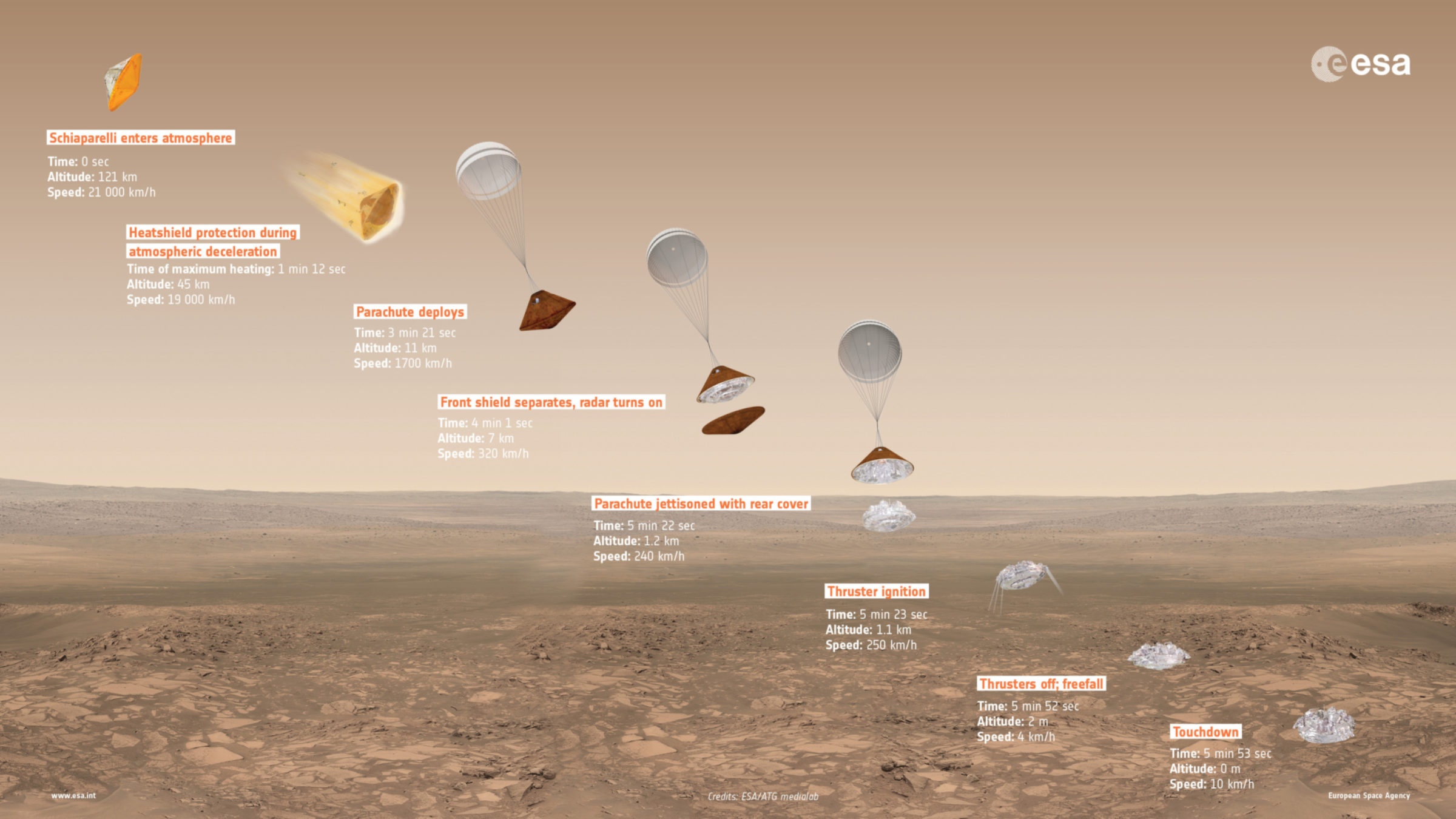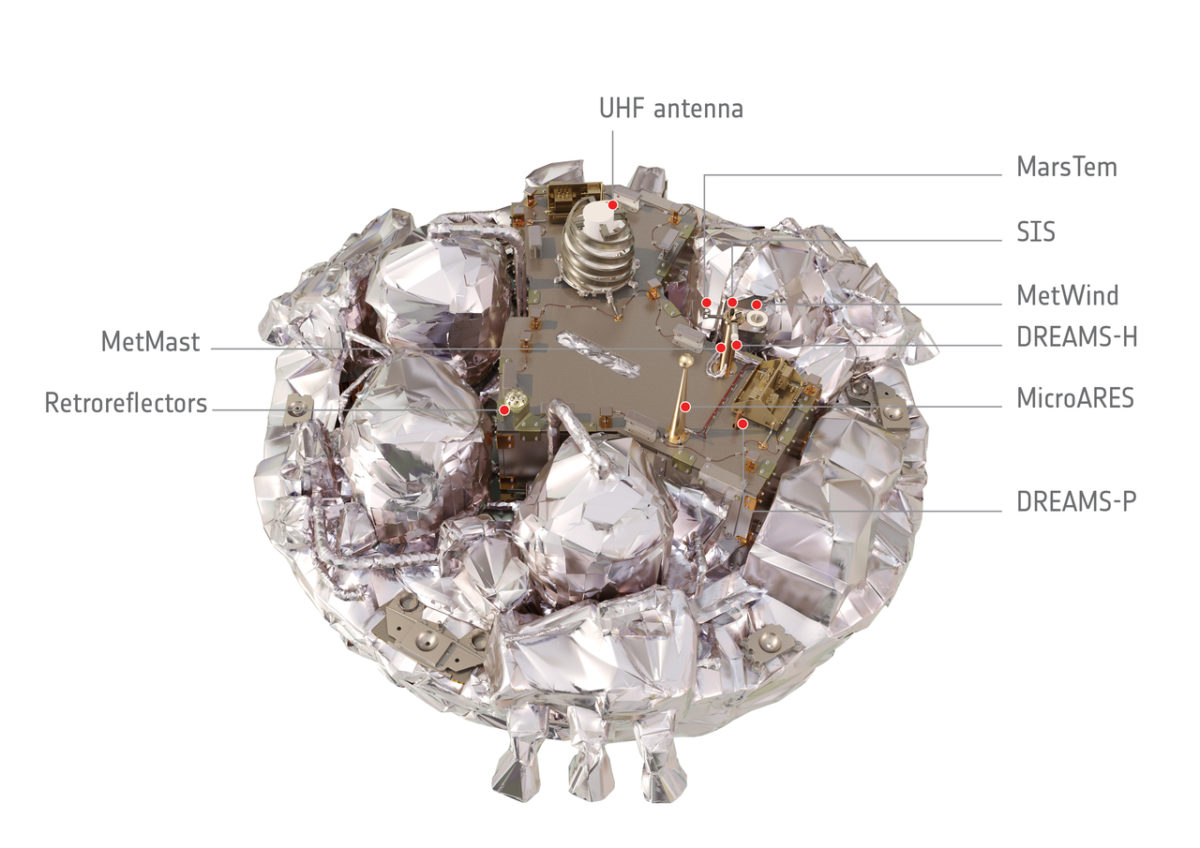Emily Lakdawalla • Mar 14, 2016
ExoMars launch successful! What to expect for the Trace Gas Orbiter and Schiaparelli missions
The ExoMars Trace Gas Orbiter and Schiaparelli lander are safely on their way to Mars! The two lifted off together aboard a Proton-M rocket with a Briz-M upper stage from Baikonur Cosmodrome at 9:31 UTC today, March 14, 2016. ESA first made contact with the spacecraft as expected twelve hours later. With the first signals, Orbiter and lander will arrive at Mars on October 19 at approximately 16:00 UTC. The lander is expected to survive about three days on the surface. The orbiter will take about a year after arrival to aerobrake into its final science orbit.

It took a three-stage rocket and four burns of an upper stage to give the 4332-kilogram ExoMars spacecraft the oomph they needed to depart Earth for Mars. Jonathan McDowell helpfully summarized all the steps via Twitter. The Proton and Briz put the spacecraft into a circular, low-Earth orbit at 185 kilometers. A second Briz burn widened the orbit and made it elliptical, reaching an apogee of 5800 kilometers. The spacecraft looped back down toward Earth. Four hours after launch, a third burn increased the height of the apogee to 21,000 kilometers. The spacecraft climbed up to the top of that orbit and fell back toward Earth one last time before a fourth burn of the Briz finally gave it the speed it needed to escape Earth's gravity. McDowell estimates that ExoMars will pass the orbit of the Moon at 03:00 UTC tomorrow (20:00 PDT tonight).
The following is paraphrased from two very useful resources about ExoMars, the media kit (PDF) and this ESA blog entry by Daniel Scuka.
Getting to Mars
The journey to Mars will take seven months. Schiaparelli will separate from Trace Gas Orbiter on October 16, 2016 at 14:42 UTC. Because Schiaparelli is powered only by batteries, it will hibernate 15 minutes after separation. In order to target the lander at Mars, ExoMars will have been on a Martian collision course. Twelve hours after separating, ExoMars will perform a trajectory correction maneuver to target its Martian orbit insertion altitude instead of Mars.
On the date of Mars arrival, the one-way light time between Mars and Earth will be 9 minutes 46 seconds. The Mars orbit insertion burn will begin on October 19 at 13:09 UTC and will last about 134 minutes. Confirmation of a successful orbit entry will come from radio tracking of the spacecraft's changing velocity by ESA and NASA ground stations at 15:23 UTC. At the same time that it is entering orbit, the Trace Gas Orbiter will be recording signals from the descending Schiaparelli.
Schiaparelli will exit hibernation briefly six hours before hitting the atmosphere, and then wake up for good at entry minus 75 minutes. Schiaparelli will hit the atmospheric entry interface on October 19 at 14:42 UTC at an altitude of 122.5 kilometers and a speed of 5.8 kilometers per second. It will use a heat shield, parachute, rockets, and finally a crushable impact structure to slow its descent to the surface. Mission controllers on Earth will not have live telemetry during the descent, because the landing is a very risky moment and the whole point is to record data about the landing process, even if (especially if) it is unsuccessful. In order to have "bent-pipe" relay as Curiosity had through Odyssey for live telemetry updates during landing, the orbiter has to decode the lander's transmissions before sending them to Earth. This is fine if everything goes well, but if something goes awry, information can be lost if the orbiter fails to decode the lander's signal.
Instead, Mars Express will record Schiaparelli's transmissions in "open loop" mode, not attempting to decode them. That way, it will have a record of whatever is transmitted, even if the transmissions are wildly out of expected frequencies due to the final dynamics of some catastrophic event. After the landing is complete (regardless of the outcome) Mars Express will package the recording and send the whole thing to Earth, where it will be decoded and interpreted. Earth will receive this recording about an hour after landing. Trace Gas Orbiter will record in the same way but will keep a longer recording, and its data will arrive on Earth later than Mars Express'. Meanwhile, the 45-meter dish of the Giant Metrewave Radio Telescope near Pune, India, will record Schiaparelli's faint signal as it descends; ESA may receive confirmation of Schiaparelli's landing through this method first.

Initial operations at Mars
Trace Gas Orbiter's initial orbit will be a highly elliptical one, 300 by 96000 kilometers in extent. It will fly in that orbit for three months. In January 17, it will use aerobraking, dipping into the very top of Mars' atmosphere, to gradually adjust its orbit to a circular one at an altitude of 400 kilometers. This has been standard operating procedure for NASA orbiters since Mars Global Surveyor, but was first tested by ESA only at the very end of the Venus Express mission; it will be ESA's first planned operational use of aerobraking. Aerobraking is expected to take Trace Gas Orbiter until November. Like previous spaccraft, Trace Gas Orbiter will be able to use some of its science instruments during the aerobraking period, but mostly at higher altitudes (and therefore with lower resolution) than they will be able to once they are in their science orbit.
Once in orbit, Trace Gas Orbiter will use four science instruments (the ACS and NOMAD spectrometers, a high-resolution stereo camera named CaSSIS, and an epithermal neutron detector called FREND) to study Mars, looking for abundances, distributions, and temporal variations in trace gases, and trying to identify their sources on the surface. Methane is a major focus, but they are also interested in aerosols, water vapor, ozone, and the deuterium/hydrogen ratio of hydrogen-bearing gases. The neutron detector is similar to the one that operated on Mars Odyssey, but will have mapped the distribution of subsurface water ice on Mars at much higher resolution by the time that the mission is over. CaSSIS is a cool camera system that takes two color images of any one spot on Mars, one looking ahead in its orbit and then a second one looking behind, producing color stereo pairs that have identical illumination in images 8 kilometers wide with 2 meter-per-pixel resolution.

Schiaparelli carries a meteorological station, a descent instrumentation package, and a descent camera. The descent camera is a flight spare of the Visual Monitoring Camera on the Herschel and Planck satellites, themselves the successors to the ones used on Cluster and Mars Express. Schiaparelli also carries laser retroreflectors for precise location of the lander on the surface from an orbital laser altimeter, though no current Mars orbiter carries such a laser.

Personally, I am skeptical that the variable methane that has been detected on Mars by Mars Express, Curiosity, and ground-based observatories is due to extant Mars life; it will take a great deal more than one spacecraft's measurements to convince me of that. That doesn't make ExoMars Trace Gas Orbiter any less interesting as a mission. The more I learn about Mars, the more I understand how important life is to Earth's geology and atmosphere. Studying Mars gives us an opportunity to study Earth without its life, and we're constantly finding unexpected chemistry there. If its mission is successful, ExoMars will give us a much more detailed picture of that chemistry and how it changes over time than we have ever had before, adding to the rich Martian story that has been developed over the last 20 years of Mars exploration by ESA, NASA, and now Roscosmos collaboration. Best of luck to ExoMars for a safe interplanetary journey and Mars arrival!
Further reading about ExoMars Trace Gas Orbiter and Schiaparelli:
- Launch press kit (PDF)
- ESA Flickr images tagged with ExoMars
- ESA launch updates
- How ExoMars/TGO gets to where it’s going (ESA blog by Daniel Scuka)
- More information about the ExoMars Instruments: ACS, NOMAD, CaSSIS, and FREND
- LPSC abstract about CaSSIS
- LPSC abstract about FREND
- Paper about ACS
- Paper about NOMAD
#MarsWebCam on #MarsExpress saw Meridiani Planum last night, the final destination for #ExoMars #Schiaparelli in Oct pic.twitter.com/GEaI9EHPEb
— ESA Operations (@esaoperations) March 14, 2016
#ExoMars seen from NL just after the end of the escape burn! @RussianSpaceWeb @planet4589 pic.twitter.com/ceVbkECZ3S
— Cees (@cgbassa) March 14, 2016
@elakdawalla we managed to get some images of ExoMars and its propellant tank after observation request from @esa pic.twitter.com/9pu9IcAJx5
— Faulkes Telescope (@faulkestel) March 14, 2016
Support our core enterprises
Your support powers our mission to explore worlds, find life, and defend Earth. You make all the difference when you make a gift. Give today!
Donate

 Explore Worlds
Explore Worlds Find Life
Find Life Defend Earth
Defend Earth

